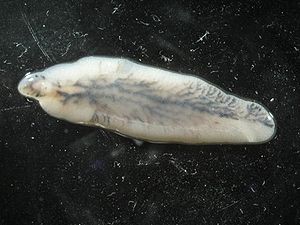
Liver fluke
Encyclopedia

Adults of liver flukes are localized in the liver
Liver
The liver is a vital organ present in vertebrates and some other animals. It has a wide range of functions, including detoxification, protein synthesis, and production of biochemicals necessary for digestion...
of various mammal
Mammal
Mammals are members of a class of air-breathing vertebrate animals characterised by the possession of endothermy, hair, three middle ear bones, and mammary glands functional in mothers with young...
s, including humans. These flatworm
Flatworm
The flatworms, known in scientific literature as Platyhelminthes or Plathelminthes are a phylum of relatively simple bilaterian, unsegmented, soft-bodied invertebrate animals...
s can occur in bile duct
Bile duct
A bile duct is any of a number of long tube-like structures that carry bile.Bile, required for the digestion of food, is excreted by the liver into passages that carry bile toward the hepatic duct, which joins with the cystic duct to form the common bile duct, which opens into the intestine.The...
s, gallbladder
Gallbladder
In vertebrates the gallbladder is a small organ that aids mainly in fat digestion and concentrates bile produced by the liver. In humans the loss of the gallbladder is usually easily tolerated....
, and liver parenchyma
Parenchyma
Parenchyma is a term used to describe a bulk of a substance. It is used in different ways in animals and in plants.The term is New Latin, f. Greek παρέγχυμα - parenkhuma, "visceral flesh", f. παρεγχεῖν - parenkhein, "to pour in" f. para-, "beside" + en-, "in" + khein, "to pour"...
. They feed on blood
Blood
Blood is a specialized bodily fluid in animals that delivers necessary substances such as nutrients and oxygen to the cells and transports metabolic waste products away from those same cells....
. Adult flukes produce eggs which are passed into the intestine
Intestine
In human anatomy, the intestine is the segment of the alimentary canal extending from the pyloric sphincter of the stomach to the anus and, in humans and other mammals, consists of two segments, the small intestine and the large intestine...
.
Examples include:
- Clonorchis sinensisClonorchis sinensisClonorchis sinensis, the Chinese liver fluke, is a human liver fluke in the class Trematoda, Phylum Platyhelminthes. This parasite lives in the liver of humans, and is found mainly in the common bile duct and gall bladder, feeding on bile...
(the "Chinese liver fluke" or the "Oriental liver fluke") - Dicrocoelium dendriticumDicrocoelium dendriticumThe Lancet liver fluke is a parasite fluke that tends to live in cattle or other grazing mammals.- History of discovery :...
(lancet liver fluke) - Dicrocoelium hospes
- Fasciola hepaticaFasciola hepaticaFasciola hepatica, also known as the common liver fluke or sheep liver fluke, is a parasitic flatworm of the class Trematoda, phylum Platyhelminthes that infects the livers of various mammals, including humans. The disease caused by the fluke is called fascioliasis . F...
(the "sheep liver fluke") - Fascioloides magnaFascioloides magnaFascioloides magna, also known as giant liver fluke, large American liver fluke or deer fluke, is an important parasite of a variety of wild and domestic ruminants in North America and Europe. Adult flukes occur in the liver of the definitive host and feed on blood...
(the "giant liver fluke") - Fasciola giganticaFasciola giganticaFasciola gigantica is a parasitic flatworm of the class Trematoda, which causes tropical fascioliasis. It is regarded as one of the most important single platyhelminth infections of ruminants in Asia and Africa...
- Fasciola jacksoni
- Metorchis conjunctus
- Metorchis albidus
- Protofasciola robusta
- Parafasciolopsis fasciomorphae
- Opisthorchis viverriniOpisthorchis viverriniOpisthorchis viverrini, common name Southeast Asian liver fluke, is a trematode parasite from the family Opisthorchiidae that attacks the area of the bile duct. Infection is acquired when people ingest raw or undercooked fish. It causes the disease opisthorchiasis...
(Southeast Asian liver fluke) - Opisthorchis felineusOpisthorchis felineusOpisthorchis felineus, or cat liver fluke is a trematode parasite that infects the liver in mammals. It was first discovered in 1884 in a cat's liver by Sebastiano Rivolta of Italy. In 1891, Russian scientist K.N. Vinogradov found it in a human, and named the parasite a "Siberian liver fluke"...
(cat liver fluke). - Opisthorchis guayaquilensis

